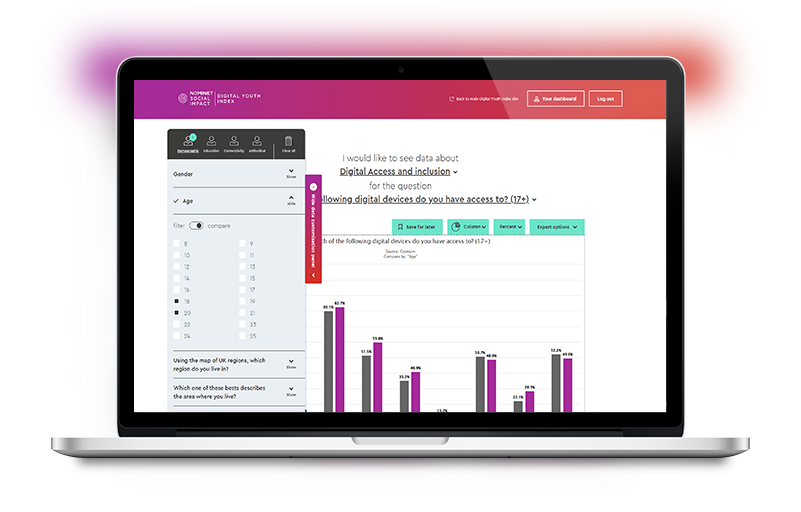This year’s report has five main pillars; digital wellbeing, internet safety, digital skills, device access and connectivity. It is perhaps no surprise that – running through all these areas of focus – is the issue of inequality. The impact of the pandemic fundamentally reshaped many children and young people’s use of technology, providing a lifeline to many but also deepening inequalities for others. The cost-of-living crisis looks like it will further accelerate some of these divides. What the Index data shows us is there is no such thing as a level-playing field online – whether it’s in terms of the ease with which individuals can access and navigate the opportunities of the online world, or the nature and impact of their exposure to harm and the detriment it might cause.
The Index is being launched just a few weeks after the inquest into the death of Molly Russell; the coroners’ full report is due to be submitted shortly to Government and Ofcom, the designated online harms regulator, but his initial conclusion was a watershed moment for social media companies in terms of identifying that online content – in this case, suicide and self-harm material, delivered to her in large volumes by the platforms’ algorithms – had played a part in her taking her own life.
The Online Safety Bill – the much delayed legislation that will impose a “duty of care” on social media platforms to reduce the risk of harm to their users – was paused before the summer recess and has still not returned to the Commons, with the new Truss government promising strengthened protections for children but “tweaks” to the measures to protect adults.
There is a lot of evidence on the role the design of the platforms played in Molly’s death that emerged in the inquest that should be uppermost in the minds of those in Government currently reviewing and revising the Bill. But they would also do well to note some striking findings from this year’s Index that tell us a bit more about the context in which children and young people consider issues surrounding their online safety.
One notable issue is the disconnect between respondents’ perception of their own safety online and the reality of the online content to which they were exposed. For example, 95% of children and young people say they feel safe online*, but the experiences they report suggest otherwise: hate speech (29% of respondents), violence (26%), trolling and abuse (23%) and sexual content (23%). In addition, 35% of respondents have seen false or misleading content: this is the material they are able to identify as false or misleading so may significantly underestimate the amount they are actually exposed to.
Another disconnect is the clarity from respondents as to where they would go for online safety help and support and the quality of that support: 51% of respondents said they would go to parents and 37% to teachers*. But when asked about the online safety advice they have had at school, the comments from Index respondents were scathing: “schools claim they teach online safety, but I don’t think it really covers the basics”; “If i’d been taught more about this, perhaps this [a scam] could’ve been avoided”; “school’s only told us the basics: don’t share your password, and don’t share valuable information .. It’s not very useful because they are already commonly known.” The survey reveals that the curriculum still has an ongoing over-emphasis on “stranger danger” and cyberbullying but with little else in the primary or secondary curriculum on how to protect yourself from, or deal with and report, harmful activity.
Given children and young people’s likely over-confidence in relation to their own levels of online safety, and their criticisms of the current curriculum’s shortcomings, the decision by the Government to remove provisions that would have strengthened Ofcom’s duty to promote media literacy from the Bill earlier this year seems even more short-sighted.
Campaigners for children as well as those focused on the need for stronger action through the Bill to address misinformation and disinformation have pushed back strongly on this omission during scrutiny of the Bill in recent months. The Government’s explanation is that OFCOM already has a statutory duty to provide media literacy through the 2003 Communications Act, and that both DCMS and Ofcom have published their own strategies on media literacy in the past year. That, they say, demonstrates that media literacy is “well covered already”. But having waited so long for this Bill – and with so many other challenges facing children and young people in an increasingly unequal digital world – it seems a great a shame that the Government has chosen not to seize the opportunity to deliver some robust and meaningful improvement to the online safety support for children and young people that – without saying it in so many words – the respondents to the index clearly desperately need.

Maeve Walsh, Policy and Government Relations Consultant
Maeve is an experienced policymaker and government relations expert who, as a Carnegie UK Associate, has worked extensively on online harms and online safety.
Share this article








